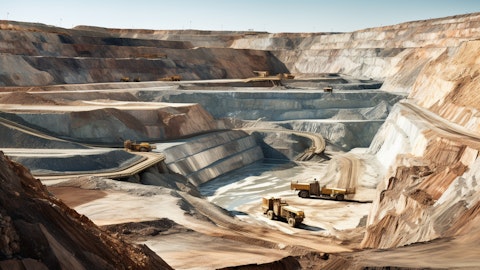Mahima Kakani : Okay, I appreciate it. Thank you.
Patrick Brindle : Thank you.
Operator: Your next question comes from the line of Greg Jones of BMO Capital Markets. Please go ahead.
Grey Jones: Good morning, Keith and Kim. My first question is regarding the timing and shipments for 2024 and looking forward. I think I heard Michael comment that the reasons for the back half shipments this year was related to timing of customer demand. How should we think about sales heading into 2025 and beyond? Do you expect that those might smooth out as the amount that you sell under contract increases relative to spot sales?
Keith Phillips: Yes, listen, I think this is an unusual year in that we had a delayed shipment. We’re shipping 126,000 tons versus 113,000 on a normal basis. So 113 would be the expected number for 2025 unless there’s some delays later this year and it’s also an unusual year in that we’re transitioning into customer shipments. So our two customers are kind of gearing up to receive material. We think they’ll be fully geared up over the course of this year to do so. Right now where we said between the two customer contracts they account for around 110,000 tons a year. Our entitlement is 113,000 tons a year. So effectively all of our material will be shipped to our contract customers beginning in 2025 on a relatively smooth basis.
Now to the extent those shipments all go by vessel there’s a possibility of things being lumpy and having two shipments one quarter, one shipment, the next, etc. So that’s something we’ll be working with our partners at Cyana on the actual shipping schedule for next year in the calendar. We’re not quite there yet, but yes this is just an unusual year. A, we have the extra shipment. B, our customers are ramping up and they don’t just need the material now, but they do need it later this year. So that’s why we have the back-ended shipments. That may work to our benefit from a pricing perspective. It may not who knows? We can’t predict lithium prices, but this will be a somewhat unusual year.
Grey Jones: Regarding Tennessee and Carolina, I appreciate the comments that your team made earlier on the call around assessing the timing of the two projects. There was a note in today’s release that Piedmont has exited the purchase agreement for the industrial complex near Tennessee. Can you please elaborate on that decision? Is there any read-through that we should take in terms of that meaning Carolina might jump ahead in the development?
Keith Phillips: It’s a good question. I would think of it more as a cash management thought. So when we secured the option on the core property in Tennessee that’s permitted, we became aware of a property just down the road, very close by. It was an industrial property that had a lot of existing infrastructure that had shut down. It was an old foundry and it was available for sale and we were in a little bit more of a frothy market where we thought Jay if we can pick that up for 4 million, 5 million it’s close by, it’s got some infrastructure that might be helpful. There may be capital efficiencies. So we optioned that property. We thought that made sense and we think it did at the time. As we kind of moved forward we realized it was a nice-to-have.
We didn’t need to have it. Our technical studies on the Tennessee Lithium Project did not contemplate having that property and writing a check in a difficult market where we’re selling non-core assets and laying people off, we just decided we just walk away from that property. It was a potential benefit for us. We hadn’t really even done all the engineering work yet to figure out how much it might benefit. The decision we made has nothing to do with the core property where we are permitted and I wouldn’t read into it anything about Carolina or the decision and who knows? We may one day secure that property again or some other property in the area. There’s lots of property that might be available, but that was really a tactical decision just based on cash management in a down market.
Grey Jones: Thanks. One final question, if I could. The DOE Loan Program office recently clarified that it may fund production or mining and extraction activities as eligible expenses. In relation to Carolina, is there an understanding that this could form a portion of the mine funding in addition to what you may be pursuing under the ATVM Loan program so you could benefit from both aspects of this more recent announcement?
Keith Phillips: Yes, we saw that — we noted that announcement with interest. That’s good. As you may know the ATVM program doesn’t extend itself to pure mining operations. It does extended lot of it – what I think of is well I think the downstream part of the upstream business. So the concentrate plant would qualify. The mining activity would not qualify. The mining share of the overall CapEx is not that high. So as we thought about Carolina historically we’ve assumed we wouldn’t have availability for a DOE Loan for that mining activity. That’s something we’re obviously re-evaluating now that would be good news and the team is just beginning to digest that and what it really means. Yes, it’s interesting there’s a lot of activity in D.C. around US Critical Minerals projects and Global Critical Minerals projects. So we’re still in discussions with the D.F.C. around Ghana, for instance. I think that’s encouraging.
Grey Jones: Great. Thank you.
Operator: Your next question comes from the line of Stephen Richardson of Evercore ISI. Please go ahead.
Stephen Richardson: Hi, good morning. Sorry to jump on late here. Couple of quick ones, Keith. On the previous comments about the timing of the off-take shipments from NAL and what the balance of the year is and just squaring what Michael said earlier in the script in terms of you could have some more spot shipments in the back part of the year? Are you dependent on kind of Tesla’s ramp-up at Corpus and kind of you probably don’t want to talk too much about your customers, but are you dependent on their ramp-up in terms of and is that creating some uncertainty in terms of what you’ll deliver for the balance of the year?
Keith Phillips: Well as you said I don’t want to talk about either customer specifically, but I think when you have a project like this with long-term off-take ability people take the material. Each of our customers are taking material into supply chains that didn’t exist a year or two ago. So the material that’s going to our other customer is kind of going through a process where a converter to convert that material is effectively building capacity for that as well. I think it’s a natural thing. Yes, it’s true if either one of these customers’ needs less material later in the year than they’re currently expecting. We would turn to spot shipments for that material. The spot market has evolved in a way that we think we can do better on spot shipments than we have done in the past, just based on some of the announcements we’ve seen from people like [indiscernible] and Albemarle and others.
Yes, it’s possible. We’ll get to a regular cadence with each of our customers. Hopefully, later this year, if it flips into 2025, that’s okay. Interestingly, as you may recall when we announced these they’re not long-term agreements. One of them is three years, it’s really 25 months and one is four years. I’m confident each of our customers is going to want to renew those. Those will be discussions we’ll have over time, but so long as we’re having material coming out of any of what we want to ship somewhere, we’re really happy with the two customers we have and with the agreements we have and looking forward to fulfilling them as their requirements really have evolved.
Stephen Richardson : Okay, that’s clear. Can you remind us as well of the payment terms on these? Is it fair to assume that you get paid more promptly on the off-takes than you do what you sell in the spot market just in terms of I appreciate some of the comments earlier on working capital?
Keith Phillips: Yeah, it’s interesting. It’s sort of the opposite in that the spot shipments are generally done via trading companies who are generally happy to prepay for the material. Let’s say it’s a $10 million shipment. They might make a provisional payment of 80% or 90% of the value of the shipment up front. That’s what happened to us last August when prices were over 3,000. We got a big provisional payment in August, and we had to reverse all that. We actually owed money to the customer because by the time it settled, it was after the delivery had occurred. In that case, I think five months later. So with our contract shipments they pay on standard terms we’ve negotiated. They don’t prepay. They pay reasonably promptly after shipment, and the timing is reasonably good and I think we’re hopeful that on average, we’ll be paid by them before we have to pay the JV.
We have 30 days effectively to pay the JV for the material. It’s interesting. We’d rather ship to our long-term customers. We think the terms are generally better for us and they’re more stable. One of the advantages of the spot market is you can get people to prepay for the material. It costs you. It’s not free. It’s a funding cost associated with it, but you can get the money up front.
Stephen Richardson: Understood. There have been a lot of things asked about Carolina. Just one last one on my part. I understood the comments on zoning. It sounds like a 2025 affair. Can you remind us where you are on EPA and how that fits in and then considering this kind of timeline plus the funding and partnership conversations, when would be the right timeline for your next cut at a DFS acknowledging that you’ve done multiple runs at this over the last couple of years?
Keith Phillips: We haven’t given a lot of thought updating the technical study, but we’ve obviously been updating technical work on an ongoing basis. We did front-end engineering design in Tennessee last year, spent a lot of money and did some good work on that. There were some good learnings from that. As you think about the timeline, we’re going to be commencing these funding discussions and strategic conversations and DOE conversations this quarter. They’re already beginning, but we’re going to formally begin them. They’ll run their course. The strategic partnership process could be multiple parties involved depending on how it rolls out, it could be announced this year, but I think bigger and comprehensive funding conclusions will kind of take place, really over the course of 2025 and we are thinking about the thinking we think your development decision is probably it would take two years from now it could be earlier and there is a question as we prepare for this.
The idea is if lithium markets recover more quickly we can move things more quickly if we want to, but at the time, that’s the way we’re thinking about it. In terms of updating technical studies we haven’t given that a lot of thought. We are updating technical work internally. We will, at some point around the conclusion of a partnering process maybe bring new economics to the market, but generally speaking we think the economics of the project remain really compelling both projects, frankly.
Stephen Richardson: And EPA, Keith?
Keith Phillips: Oh, sorry. The air permit is underway. I think we’re hoping to accomplish that air permit this year. I think we have October sort of slotted in as a target, but these are moving targets. Some of the details around requirements have changed during the permitting process. So we’re accommodating that and doing fresh work. We’ve obviously received an air permit in Tennessee. We received an air permit for our Kings Mountain property three or four years ago. We’re pretty comfortable with that process. We don’t see that as a particularly significant risk, but from a timing perspective that’s something we are targeting for the second half of the year.
Stephen Richardson: Okay. Thanks.
Operator: There are no further questions. I will now turn the conference back over to Irene Sanders for closing remarks.
Erin Sanders: Thank you. That concludes our call today. As a reminder, you can find our earnings release presentation and a replay of this call on our website. And we thank you for your time and interest in Piedmont Lithium.
Operator: Ladies and gentlemen, that concludes today’s call. Thank you all for joining, you may now disconnect.
Follow Pall Corp (Old Filings) (NASDAQ:PLL)
Follow Pall Corp (Old Filings) (NASDAQ:PLL)
Receive real-time insider trading and news alerts





